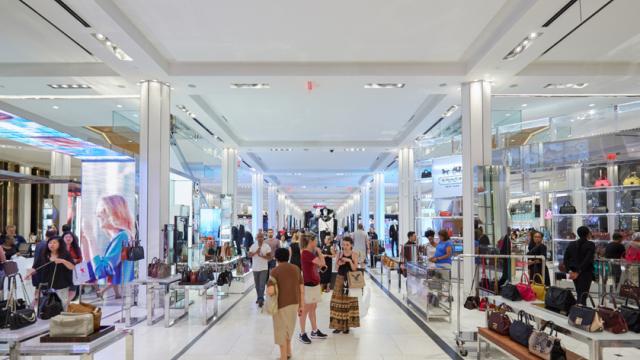In retail spaces, lighting is important for attracting potential customers, creating ambiance and for drawing attention to merchandise. Because most purchasing decisions are made at the point of sale, it's important to recognize lighting as a key sales tool. If used effectively, lighting can dramatically improve the visual appeal of any retail environment.
Defining the space
According to the Illuminating Engineering Society, there are three primary types of retail space in terms of lighting: low, medium, and high activity. Each space is also defined in terms of the tasks taking place in different areas of that space:
• Circulation — areas not being used predominantly for display purposes
• Merchandise — shelving or showcases for general merchandise display
• Feature — special items are highlighted to set them off from surrounding areas
Retail facilities often include all three task and activity types, and each type includes specific lighting requirements. In general, merchandise and feature display areas are lit at levels four to five times brighter than circulation areas.
High-activity spaces
The merchandise displayed in these areas is easily recognizable. Customers generally spend little time viewing and evaluating individual items and need little assistance in reaching buying decisions. Big box, grocery and discount department stores typically have high-activity spaces. In these areas:
• Lighting systems are usually static to provide uniform illumination and follow the pattern of merchandise layout.
• Recommended lighting levels range from 20 footcandles in circulation areas to 50 footcandles in merchandise areas and up to 500 footcandles if feature displays are used.
Medium-activity spaces
Merchandise on display is typically familiar or recognizable to customers, but they may require additional time or help in evaluating quality, or in reaching a buying decision. Customers are more likely to spend time shopping; quickly finding and buying items is less of a concern. Traditional department stores are prime examples of medium-activity retail spaces. In these spaces:
• Somewhat warmer color temperatures should be considered to create a more relaxed atmosphere.
• Merchandise and display areas are typically kinetic lighting systems that can be moved and reset.
• Recommended light levels are 15 footcandles for circulation areas, 40 footcandles for merchandise areas and 400 footcandles for feature displays.
Low-activity spaces
These spaces generally include merchandise exhibited in high-profile displays. Assistance is often required for access to merchandise and in making purchasing decisions. Lighting should create a low-key, intimate atmosphere. Examples of low-activity retail spaces include boutique jewelry stores and art galleries. In these settings:
• Less emphasis is placed on general lighting in circulation areas and more on accenting merchandise and featured display items.
• Lighting level recommendations range from as low as 10 footcandles for circulation areas, to 30 footcandles for merchandise areas, and no more than 150 footcandles for feature displays.
LEDs light the way
LEDs use less energy and last longer than conventional lighting. They also offer a number of benefits for retailers:
• Improved light quality. Light quality is how a light source displays the color of objects. The better light quality provided by LEDs can help make displays really pop.
• Better direction. Unlike conventional lamps, LEDs emit directional light, allowing you to more easily highlight products on display, increase design flexibility and control.
• Adjustable colors. Color-tunable LED fixtures allow you to create more dynamic displays. You can change the color tone from a warm to cool appearance, or mix colors to create a distinctive pattern.
With their many benefits, LEDs optimize energy savings and put retail spaces in the best possible light.
Our Commercial Direct Install (CDI) program can help your business upgrade its lighting and lighting systems—all at no cost to you. Visit ladwp.com/cdi for more information.
December 2023 Empowering Small Business
LADWP's monthly Empowering Small Business Newsletter helps inform industry-specific small business customers about LADWP news, conservation programs and ways to save on their bill.
Full Newsletter